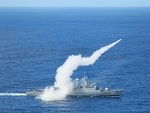http://en.wikipedia.org/wiki/Ohio-class ... onversionsSSBN/SSGN conversions
After the end of the Cold War, plans called for Ohio to be retired in 2002, followed by three of her sister boats. However, Ohio, Michigan, Florida, and Georgia instead were slated for modification, to remain in service carrying conventionally armed guided missiles, and were redesignated as SSGNs.
Beginning in 2002 through 2010, 22 of the 24 88 inches (2.2 m) diameter Trident missile tubes were modified to contain large vertical launch systems (VLS), one configuration of which may be a cluster of seven Tomahawk cruise missiles. In this configuration, the number of cruise missiles carried could be a maximum of 154, the equivalent of what is typically deployed in a surface battle group. Other payload possibilities include new generations of supersonic and hypersonic cruise missiles, and Submarine Launched Intermediate Range Ballistic Missiles (SLIRBM), unmanned air vehicles (UAVs), the ADM-160 MALD, sensors for anti-submarine warfare or intelligence, surveillance, and reconnaissance missions, countermine warfare payloads such as the AN/BLQ-11 Long Term Mine Reconnaissance System (LMRS), and the broaching universal buoyant launcher (BUBL) and stealthy affordable capsule system (SACS) specialized payload canisters.
The USS Ohio being converted from an SSBN to an SSGN in March 2004.
The missile tubes also have room for stowage canisters that can extend the forward deployment time for special forces. The other two Trident tubes are converted to swimmer lockout chambers. For special operations, the Advanced SEAL Delivery System and the Dry Deck Shelter can be mounted on the lockout chamber and the boat will be able to host up to 66 special operations sailors or Marines, such as Navy SEALs, or USMC MARSOC teams. Improved communications equipment installed during the upgrade allows the SSGNs to serve as a forward-deployed, clandestine Small Combatant Joint Command Center.
On 26 September 2002, the Navy awarded the Electric Boat company a US$442.9 million contract to begin the first phase of the SSGN submarine conversion program. Those funds covered only the initial phase of conversion for the first two boats on the schedule. Advanced procurement was funded at $355 million in fiscal year 2002, $825 million in the FY 2003 budget and, through the five-year defense budget plan, at $936 million in FY 2004, $505 million in FY 2005, and $170 million in FY 2006. Thus, the total cost to refit the four boats is just under $700 million per vessel.
The USS Ohio being converted from an SSBN to an SSGN in March 2004.
The helm of the Ohio-class guided-missile submarine, USS Florida (SSGN-728), in March 2010.
In November 2002, Ohio entered a drydock, beginning her 36-month refueling and missile conversion overhaul. Electric Boat announced on 9 January 2006 that the conversion had been completed. The converted Ohio rejoined the fleet in February 2006, followed by the Florida in April 2006. The converted Michigan was delivered in November 2006. The converted Ohio went to sea for the first time in October 2007. Georgia returned to the fleet in March 2008 at Kings Bay. These four SSGNs are expected to remain in service until about 2023–2026. At that point their capabilities will be replaced with Virginia Payload Module equipped Virginia-class submarines.
Actualmente, são 14 SSBN e 4 SSGN. Os SSBN, ou boomers, estão armados com até 24 mísseis nucleares UGM-133 Trident II (D5), todos armazenados em silos verticais, tal como os Tomahawks nos SSGN.







